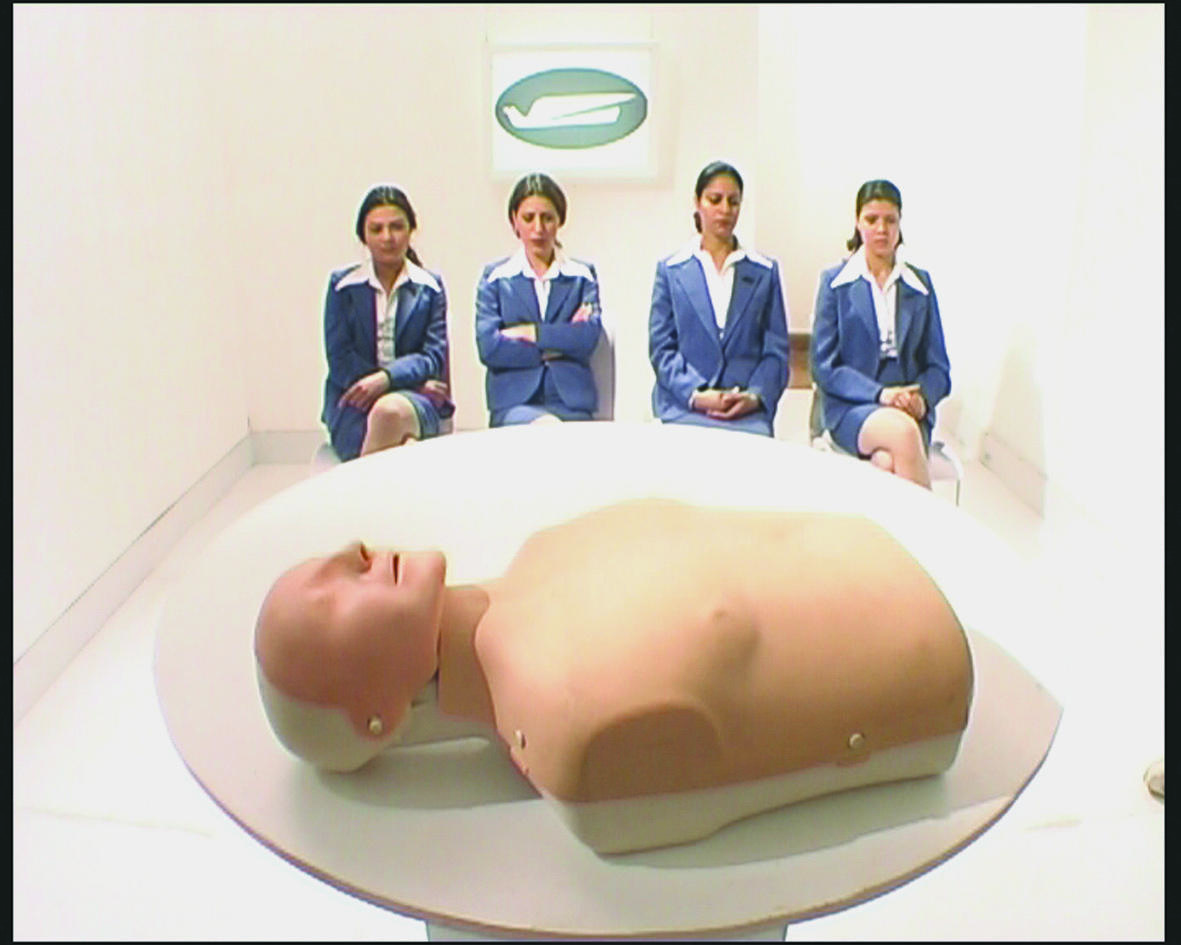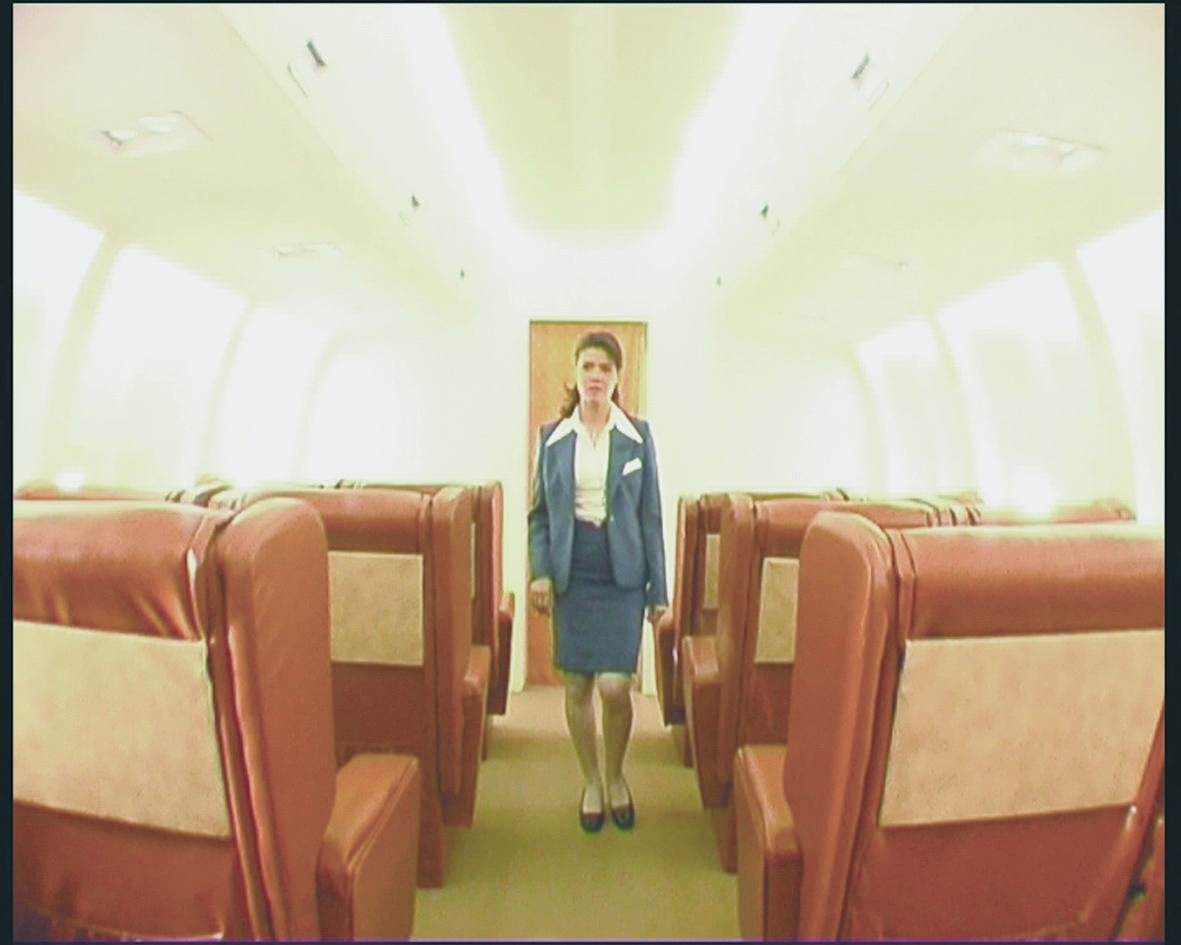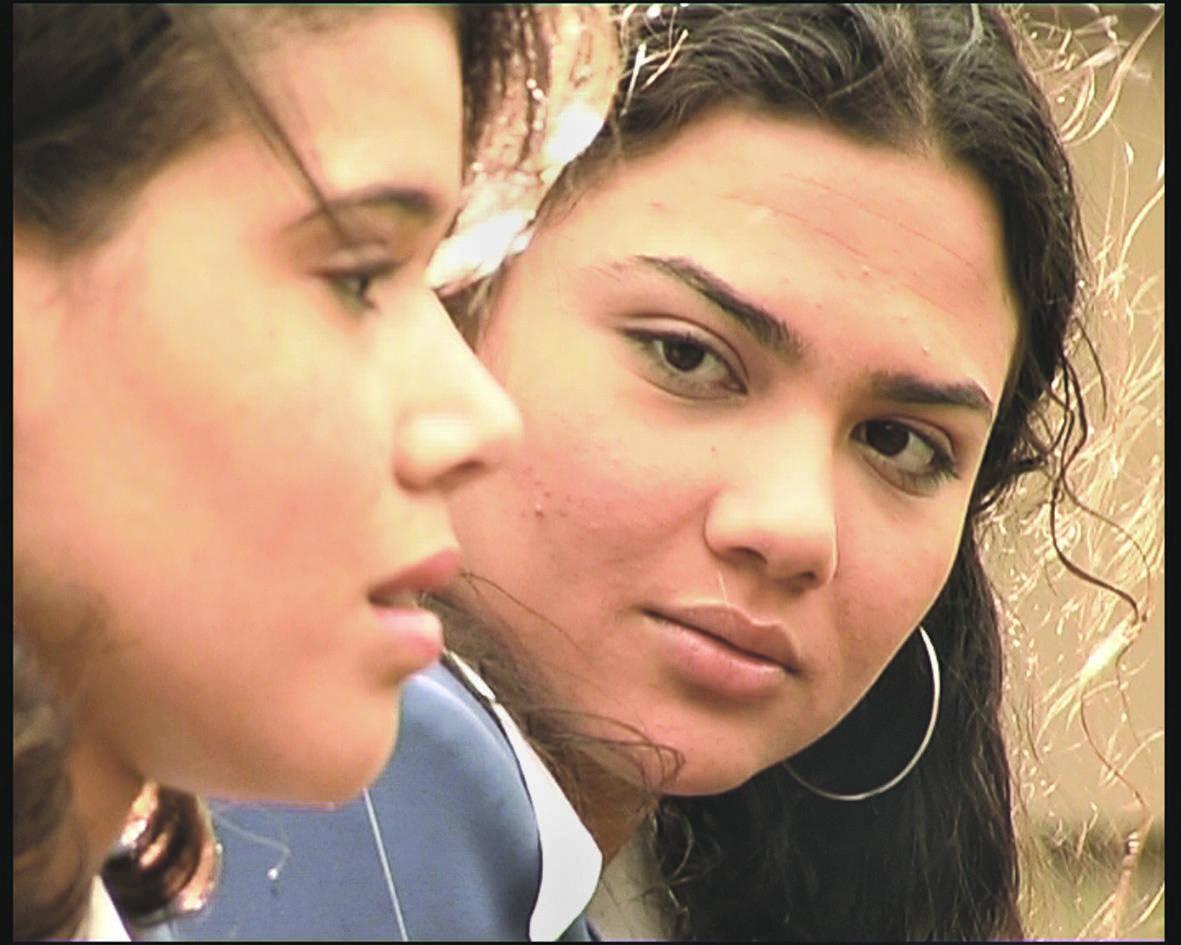
Sherif El Azma’s video/film Television Pilot for an Egyptian Hostess Soap Opera is brilliant. In the world of the film, characters struggle to maintain their positions vis-à-vis each other. Tensions, envies, jealousies and desires produced by that struggle coexist as part and parcel of a context in which personas are both defined and limited by the expectations of the system within which they function. El Azma’s film avoids becoming a melodrama of strangers by focusing on the ambiance and atmosphere through which a strange twist of events occurs.
The action that unfolds is pretty simple. In the first half a group of young hostess trainees engage in a series of exercises and games in the headquarters of a fictional airline — during which they subtly compete against one another. Cut to a few months later in mid-flight (or are they two separate journeys intercut together?) and we’re with Farah and Lela, air hostesses and erstwhile competitors, colleagues and friends. On the flight they meet the enigmatic (and freaky looking) Count and his sleazily suave business manager, Mustafa. The film ends three minutes before landing, with Lela practicing her smile in front of the mirror. And that’s it. No narrative arcs, plots, complications or resolutions, no cathartic sacrifices and judgements, but rather an engaged and engaging suspension.
The film tackles the emotional depth of the characters by bringing two, apparently contradictory elements to the fore — the complexity and ambiguity of motivations on one hand and the concrete nature of context on the other. It is an approach that allows us to engage with the emotional life of the subjects while steering away from the ersatz glitz of the glamorized heroes and victims that are the staple of mainstream media.
El Azma’s focus on young women is at once scathing and gentle. Allowing the characters the depth of possessing contradictions makes the encounters between these aspiring young women (though, it is unclear what they aspire to exactly) ambiguous and profound. In these encounters a conflicting mixture of emotions and needs (friendship, love, desire, envy and competition) are experienced. Their constant negotiation is also a way of coming to terms with the world they share.
FLYING WOMEN

“Women” as dramatic tools have a long history of inhabiting a specific position within the cultural unconscious. They are forced to function as symbols, to carry the weight of redeeming the betrayals of drama. The pressures stemming from the everyday manifestation of such assumptions (and their internalization) is the emotional motor of the film. The complexity and contradiction of treating the characters as both objects of desires and active subjects possessing agency — are what lends them a multi-dimensionality that removes them from merely being objects of our passive admiration or condemnation. We are forced to deal headlong with what is stubbornly complex, what refuses to dissolve itself.
In the opening scenes of the film, four aspiring hostesses engage in a series of exercises. The interrelationship between their personal desires and the world with which they are struggling with is evident throughout, while their trainer, a powerful older female figure perfectly played by Menha El Batrawy, acts as their guide and maintains a pregnant tension. In this land of looks, gestures and negotiations, these young women search for an image of themselves that affirms their respective aspirations as well as their sense of self-worth.
HURTLING THROUGH THE SKIES: STYLE AND THE LANGUAGE OF DREAMS

As its title indicates, Pilot is marked by a conscious engagement with the tropes of mainstream drama, but it manages to maintain a distance from the limits of that genre. An investigation of drama, character and narrative is underway without sinking into a homogenous, complacent reiteration of the genre’s tendencies. A film masquerading as a television soap opera pilot complicates the conceptual ramifications of our expectations as to how mass culture (that great unconscious) tackles similar themes. El Azma’s focused insistence on producing content through process, rather than opting for a smug, arrogant ironic distance, ensures the film’s sophistication. For here, over a few months, the director brought together a group of young actresses and proceeded to work with them in a process based upon improvisation. Out of these improvisations characters were discovered, and played out as a series of relations rather than as internalized entities. Thus, tight and taut, the interplay between the characters manages to unconsciously betray their motives, fears, and desires through the everyday language of gestures, looks and words. Characters do not explain themselves as much as engage with each other.
One of the film’s strengths is its ability to maintain a stylistic coherence while utilizing different shooting and editing styles — from hand-held sequences in which the camera becomes the emotional register of the actions it records to well composed shots that reference the aesthetics of high modernism and the sci-fi of b-movie extravaganza. The visual style is more concerned with the unconscious permutations of the culture that exists within the film than with the necessities of driving a specific plot forward, and although suspense and expectation are played with, they function here as a layer of the emotional field rather than as a method to entice the viewer.
El Azma’s unforced pace, the casual manner in which he manages to construct (art direction, lighting, camera angles and movement) his images as a repository of depth, is part of an approach in which meaning is sensed and discovered rather than declared. In an especially poignant scene, Mustafa dons a sleeping mask and proceeds to flirt with one of the women. In another the hostesses in training practice mouth-to-mouth resuscitation on a male dummy. Uncomfortable and ambiguous, these images speak of a location that is beyond their mere concrete manifestation — gestures towards an invisible eye, toward what we can sense but not explain.